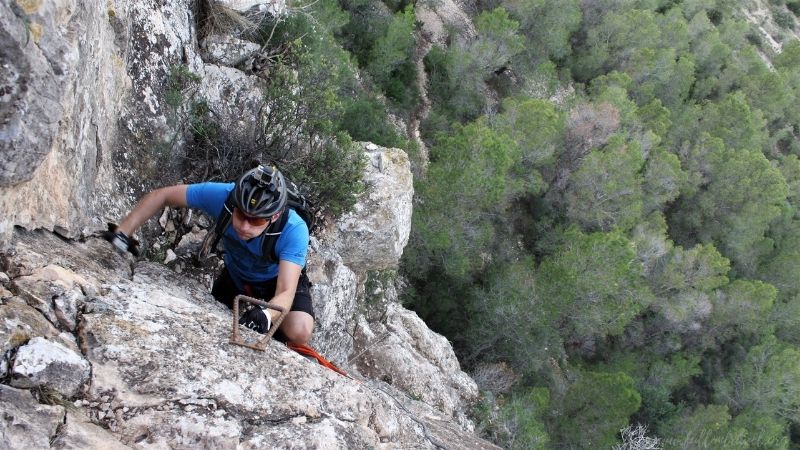For those who are adventurous during their holiday on the Costa Blanca, I recommend taking your via ferrata equipment with you. There are several via ferratas near Murcia, which are not extremely demanding but can give you an adrenaline rush. One of them: Vía Ferrata Sierra del Lúgar, is probably my favourite Spanish that I have climbed.
In fact, it was one of the few via ferratas on our journey from Andalusia to Alicante.
The neighborhood itself seems quite inconspicuous. If not for the exact coordinates, we could have a problem with the location of the parking lot. That was a few years ago. Now you can easily google it. The summit is impressive from a distance, informing you that it won’t be one of those easy routes.
- Difficulties: K3, K4, K5
- Rope: optional 1x60m, 2x30m or 1x70m
- Ziplines: 0
- Bridges: 0
- Approach time: 20 minutes.
- Climbing time: 1 hour
- Descent time: 30 min
- Initial altitude: 517m
- Final height: 651m
- Ferrata length: 260 meters
- Elevation: 134m (only ferrata)
Approach
To get to the wall, you have to go through the olive grove, then go up the hill through the trees.
The path is quite well marked. Here and there, you can see stone mounds and hanging red ribbons informing about the direction.
At the moment, the path forks, and there are two ways to start the route. The first, where the initial section is valued at K4, and the second, slightly higher valued at K3. We didn’t realize it at the time, so we got to the bottom of a more difficult section.
Via ferrata
After reaching the wall, it turns out that the initial fragment, which is valued at K4, does not have many metal rugs or ladders, which I took as an advantage. Of course, there is an iron cable along the climbing route, but most of the time, you climb the rock formation, only in some places with the help of fixed steps.
After the first dozen meters, we knew that it would not be easy!
The wall is steeply sloping. We were quickly gaining height from where we could admire the view of the surrounding groves.
Yes, sure. Of course not!
Until we climbed onto a larger rock shelf, there was no way to rest.
It was Paweł’s second via ferrata in his life and the first so difficult! We had to stay focused.
We consciously didn’t take the rope with us, leaving ourselves no other way than to climb to the top! Perhaps in retrospect, I should say this is a mistake. Truth. But I won’t dim. There was not enough room for the rope in the suitcase. (you probably know these dilemmas, right?).
The next fragment was technically a bit easier. We had a pillar of several meters to overcome. Initially, you traverse it on the left side, then you have to climb the wall, but there are already some iron rugs.
After passing this bulge, we decided to rest. We figured out where the route was going, and it looked both exciting and challenging!
What can I say, the wall is vertical, 50 meters tall! Some sources say 70 meters, but I generally haven’t found any official information about how much this wall has.
Everyone knows the principle rule that you do not fall off ferratas. The flight here would be particularly unpleasant. This fragment is probably valued at K5 due to its exposure and height.
It seemed to me that I was physically prepared for this. I’ve had a year of rock climbing, so it can’t be harder since you have stairs, right, haha?
Nothing could be more wrong, you usually don’t climb on biceps, but it’s worth having it in case of a blockage. 🙂 Anyway, with good reason, a greeting sign with the words “Fiesta de Los Biceps” hangs!
Yes, it was definitely a challenge! Initially, we climbed vertically upwards, then traversed to the right. The steps and handles were quite apart. And from here again vertically upwards of few dozen meters!
Paweł wasn’t super happy. Every now and then, I stopped to take pictures while Paweł urged me on to get it over with. I think our experiences with this passage were extremely different!
But the happiness and satisfaction after reaching the top were overwhelming for both of us. Beautiful views!
For most of us, Spain reminds mainly of the coast, palm trees, and the sun.
Here, however, the harsh desert climate prevailed. I have already traveled so many kilometers in Spain that it wasn’t a big surprise, but it’s always impressive.
Descent
We spent some time at the top, then went down the path to the main road, led by sheep grazing in the area. The path marked with red ribbons also leads to descent. When you reach the fork, you can rappel the rope 25 meters or continue downhill towards the forest until you reach the olive fields and parking lot.
It was only a prolonged hike down that made me realize how high we climbed.
The ferrata ends at the top at an altitude of 651 m above sea level. And starts at an altitude of 517 m above sea level. We covered 136 meters of elevation, and the entire via ferrata was about 260 meters long.
The greater satisfaction I felt. 🙂
How to get there
By car from Fortuna, we drive towards Garapacha on the A-17 road. At Las Casicas, there is a left turn towards Landing on the A-20 road. About 2 km further, there is a wide parking lane on the right and Sierra del Lúgar on the opposite side of the road. When typing Parking Ferrata Sierra del Lúgar, you will get there without any problems.
What to bring with you: harness, helmet, a rope is optional, but I do not recommend retreating on this ferrata without a rope. Comfortable shoes with good grip. Something to eat and drink. If you would like to try to measure your forces climbing the via ferrata, you can go for a guided trip also.
What do you usually do during you holiday in Spain? Share with us!












Recent Comments